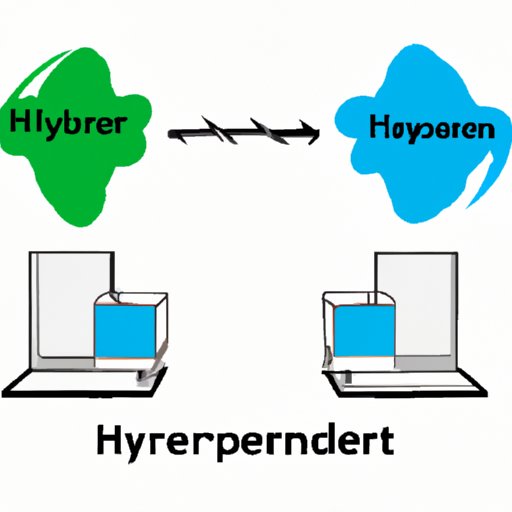I. Introduction
Imagine being able to run multiple operating systems on one physical server or computer without the need for multiple hardware? That’s where the role of hypervisors in virtualization becomes crucial. Hypervisors have significantly impacted virtualization by allowing the separation of hardware from software, creating a virtualized environment that is cost-effective and efficient. In this guide, we’ll explore everything you need to know about hypervisors, including their advantages, types, potential drawbacks, and providers, among others.
II. The Beginner’s Guide to Understanding Hypervisors
So what is a hypervisor? In simple terms, a hypervisor is a virtualization technology that enables the creation and management of multiple virtualized environments on a physical server or computer. It does this by creating a layer of software between the physical hardware and the virtualized environment. Hypervisors work by allocating system resources such as CPU, memory, and storage to the virtual machines to ensure they run smoothly. They also provide support for multiple operating systems, making it possible for users to run Linux, UNIX, and Windows OS on one system.
The benefits of using hypervisors for virtualization are numerous. Firstly, they help with reducing hardware costs by allowing the sharing of system resources. Additionally, by reducing the physical footprint of servers, they help in reducing power consumption and workspace requirements. Hypervisors also provide flexibility, as they allow you to create and manage virtual machines easily, and independently of each other. This saves time, as well as makes it easy to custom configure each virtual machine to suit specific needs.
III. Why Hypervisors are the Future of Virtualization
Hypervisors are taking virtualization to the next level by providing advantages that traditional virtual machines cannot match. For instance, hypervisors offer more security and stability by isolating workloads, preventing a single point of failure, making it easy for IT administrators to control access and monitor usage, and enabling quick disaster recovery protocols. Hypervisors are also versatile, making them popular among businesses and industries that require uptime, performance, and scalability. Examples of such industries include healthcare, finance, and telecommunications, among others. Hypervisors’ popularity is growing and is likely to continue to do so in the future, as more businesses look to adopt virtualization as an essential part of their IT infrastructure.

IV. Everything You Need to Know About Different Types of Hypervisors
The market has two types of hypervisors: type 1 hypervisors and type 2 hypervisors. Type 1 hypervisors are known as ‘bare-metal hypervisors’ and do not require an underlying operating system to work. Type 2 hypervisors, on the other hand, are installed on top of the existing operating system.
Type 1 hypervisors are known for their performance, security, and stability, as they run directly on the hardware and have little to no overhead. In contrast, Type 2 hypervisors offer users more flexibility, as they can be used to test, develop or run applications without affecting the host operating system. Examples of popular hypervisors include VMware ESXi, Microsoft Hyper-V, Citrix XenServer, and Oracle VM VirtualBox.
V. Maximizing Efficiency: How Hypervisors Can Help Streamline Your Workflow
Hypervisors can help streamline your workflow in various ways. They can help in consolidating workloads, reducing hardware, energy, and maintenance costs, improving availability and deployment, and enhancing disaster recovery capabilities. Setting up hypervisors requires careful planning and execution, including selecting the right hypervisor, virtual machine creation, allocation of resources, and storage configuration, among others. Fortunately, many businesses have successfully implemented hypervisors, and in most cases, feedback has been positive. Testimonials from such companies suggest that hypervisors can help businesses improve their productivity and stay ahead of the competition.
VI. The Pros and Cons of Using a Hypervisor for Virtualization
Although hypervisors offer numerous benefits, they are not a one-size-fits-all solution in all virtualization scenarios. The costs involved in setting up, configuring, and maintaining hypervisors can be significant, and businesses must consider their budgets before implementing them. Additionally, some applications may not be compatible with virtual machines, and businesses must conduct a feasibility study before implementing hypervisors. Security concerns are also another downside of hypervisors. Businesses must take steps to ensure that their virtual machines are secure as part of their IT security policies and procedures.
VII. Navigating the Complex World of Hypervisor Security Features
Hypervisor security features are essential in ensuring the protection of virtual machines and data stored in them. Hypervisors come with advanced security features such as access control, network segmentation, encryption, and disaster recovery, among others. However, businesses must navigate the complex world of implementing these features, as doing so requires an advanced understanding of virtualization, networking, and IT security. Fortunately, many businesses are investing in hypervisor security training and certification for their IT staff to mitigate security risks and provide assurance to clients and stakeholders.
VIII. A Comprehensive Comparison of the Top Hypervisor Providers on the Market
Choosing the right hypervisor provider can be a daunting task, given the numerous options available in the market. The decision on the right provider will depend on various factors such as cost, performance, reliability, and flexibility. It’s essential to conduct careful research and evaluation of each provider’s features, including scalability, compatibility, support, and ease of use. Some popular hypervisor providers in the market today include Citrix, Microsoft, Oracle, and VMware, among others. Each has its strengths and weaknesses, and businesses must evaluate each option carefully before deciding on the best provider for their needs.
IX. Conclusion
In conclusion, hypervisors are essential in virtualization and have numerous benefits, including cost-effectiveness, efficiency, flexibility, and security. Although hypervisors have some limitations and potential risks, they offer businesses a competitive edge and ability to stay ahead of the curve. By implementing hypervisors in their IT infrastructure, businesses can consolidate workloads efficiently, improve IT security, maximize efficiency, and streamline their workflows. It’s important to choose the right hypervisor provider and train their IT staff to navigate the complex world of hypervisor security features.
By taking the necessary steps, businesses can take advantage of the new horizons created by hypervisors’ innovative technology, which shows no signs of slowing down in the future.
